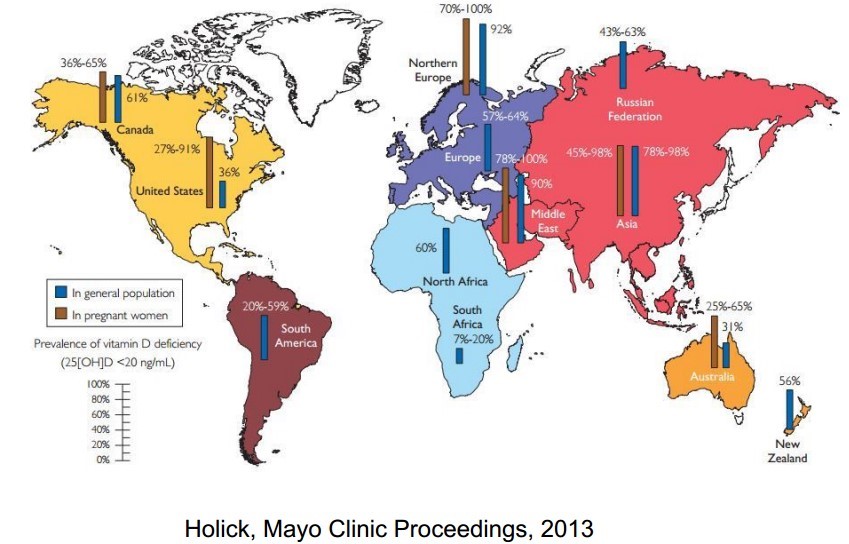Vitamin D levels in moms and infants are low and sometimes very low
Global summary of maternal and newborn vitamin D status – a systematic review
Rajneeta Saraf1, Susan M.B. Morton1, Carlos A. Camargo Jr.2 and Cameron C. Grant1,3,4,*
Maternal & Child Nutrition, Article first published online: 15 SEP 2015, DOI: 10.1111/mcn.12210
Pregnant women and newborns are at increased risk of vitamin D deficiency. Our objective was to create a global summary of maternal and newborn vitamin D status. We completed a systematic review (1959–2014) and meta-analysis of studies reporting serum 25-hydroxyvitamin D [25(OH)D] concentration in maternal and newborn populations. The 95 identified studies were unevenly distributed by World Health Organization (WHO) region: Americas (24), European (33), Eastern Mediterranean (13), South-East Asian (7), Western Pacific (16) and African (2).
Average maternal 25(OH)D concentrations ( nmol L−1 ) by region were
47–65 (Americas),
15–72 (European),
13–60 (Eastern Mediterranean),
20–52 (South-East Asian),
42–72 (Western Pacific) and
92 (African).
Average newborn 25(OH)D concentrations (nmol L−1) were
35–77 (Americas),
20–50 (European),
5–50 (Eastern Mediterranean),
20–22 (South-East Asian),
32–67 (Western Pacific) and
27–35 (African).
The prevalences of 25(OH)D <50 and <25 nmol L−1 by WHO region in pregnant women were: Americas (64%, 9%), European (57%, 23%), Eastern Mediterranean (46%, 79%), South-East Asian (87%, not available) and Western Pacific (83%, 13%). Among newborns these values were: Americas (30%, 14%), European (73%, 39%), Eastern Mediterranean (60%, not available), South-East Asian (96%, 45%) and Western Pacific (54%, 14%).
By global region, average 25(OH)D concentration varies threefold in pregnant women and newborns , and
prevalence of 25(OH)D <25 nmo L−1 varies
eightfold in pregnant women and
threefold in newborns .
Maternal and newborn 25(OH)D concentrations are highly correlated. Addressing vitamin D deficiency in pregnant women and newborns should be a global priority. To protect children from the adverse effects of vitamin D deficiency requires appropriate interventions during both pregnancy and childhood.
Publisher wants $6 to rent the PDF
See also VitaminDWiki
3X more kids were vitamin D deficient when entering UK hospitals than 4 years before – Oct 2014
Breastfed infants: 90 percent had less than 20 ng of vitamin D, formula-fed: 15 percent – May 2013
- Note: the study on this page does not distinguish breastfed from forumula fed infants
Unsupplemented infants were 19X more likely to be vitamin D deficient - May 2012
Routine monitoring of vitamin D during pregnancy is mandatory (Engl. and Port.) - May 2015
Pregnant women are vitamin D deficient - Map 2013
- Brown bar = % of pregnant women with < 20 ng

Infant-Child Intervention trials using Vitamin D:
{category}
